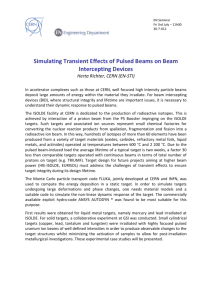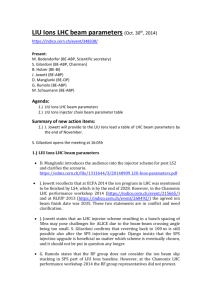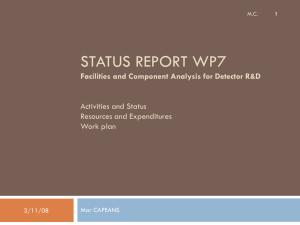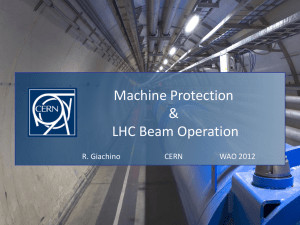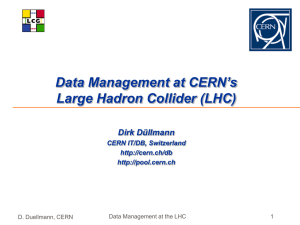Research Activities and Project Detail
advertisement
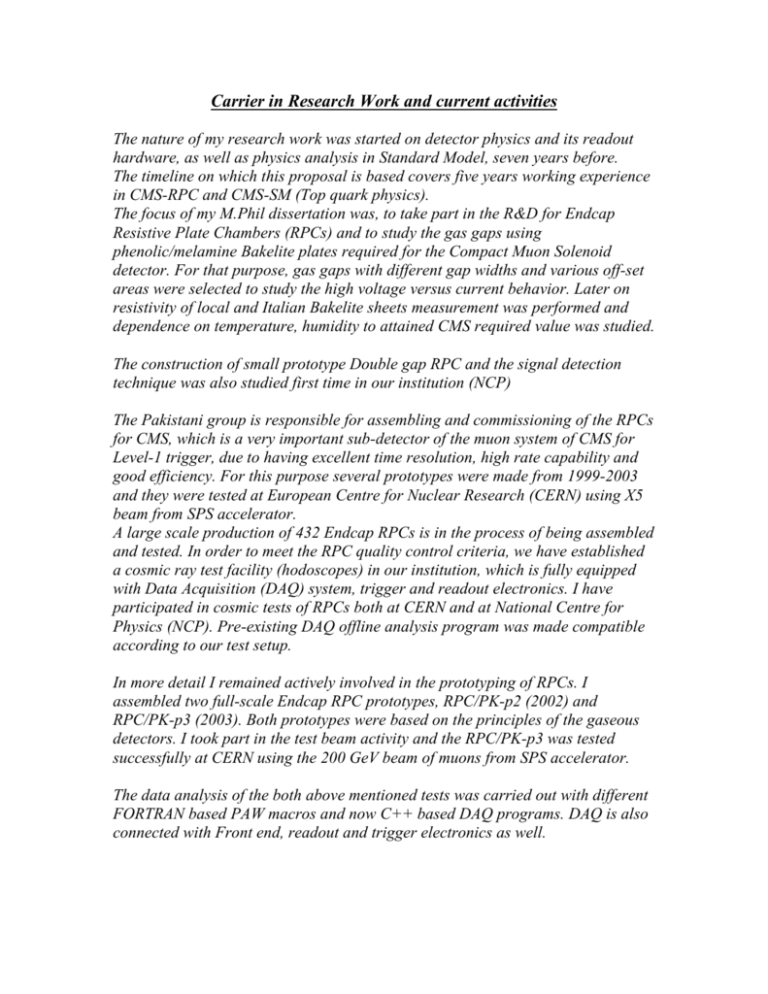
Carrier in Research Work and current activities The nature of my research work was started on detector physics and its readout hardware, as well as physics analysis in Standard Model, seven years before. The timeline on which this proposal is based covers five years working experience in CMS-RPC and CMS-SM (Top quark physics). The focus of my M.Phil dissertation was, to take part in the R&D for Endcap Resistive Plate Chambers (RPCs) and to study the gas gaps using phenolic/melamine Bakelite plates required for the Compact Muon Solenoid detector. For that purpose, gas gaps with different gap widths and various off-set areas were selected to study the high voltage versus current behavior. Later on resistivity of local and Italian Bakelite sheets measurement was performed and dependence on temperature, humidity to attained CMS required value was studied. The construction of small prototype Double gap RPC and the signal detection technique was also studied first time in our institution (NCP) The Pakistani group is responsible for assembling and commissioning of the RPCs for CMS, which is a very important sub-detector of the muon system of CMS for Level-1 trigger, due to having excellent time resolution, high rate capability and good efficiency. For this purpose several prototypes were made from 1999-2003 and they were tested at European Centre for Nuclear Research (CERN) using X5 beam from SPS accelerator. A large scale production of 432 Endcap RPCs is in the process of being assembled and tested. In order to meet the RPC quality control criteria, we have established a cosmic ray test facility (hodoscopes) in our institution, which is fully equipped with Data Acquisition (DAQ) system, trigger and readout electronics. I have participated in cosmic tests of RPCs both at CERN and at National Centre for Physics (NCP). Pre-existing DAQ offline analysis program was made compatible according to our test setup. In more detail I remained actively involved in the prototyping of RPCs. I assembled two full-scale Endcap RPC prototypes, RPC/PK-p2 (2002) and RPC/PK-p3 (2003). Both prototypes were based on the principles of the gaseous detectors. I took part in the test beam activity and the RPC/PK-p3 was tested successfully at CERN using the 200 GeV beam of muons from SPS accelerator. The data analysis of the both above mentioned tests was carried out with different FORTRAN based PAW macros and now C++ based DAQ programs. DAQ is also connected with Front end, readout and trigger electronics as well. I am also working on the physics topics related to the physics of Large Hadron Collider (LHC) under construction at European Organization for Nuclear research (CERN), Geneva, Switzerland. Talking about my main physics field of study is the production of top anti-top quark pairs at LHC through gluon fusion, which has the dominant cross-section over all other production mechanisms. Since LHC would be a top factory, so it will allow us to measure more precisely the mass of the top quark in lepton plus jets channel, which a key parameter is to bound the Higgs mass. Basic Idea of top physics study at LHC: More than one top mass estimator is required in any experiment one of them is the high Pt top analysis. In which highly boosted top quarks decay back-back making two hemispheres inside the two parts of the detector. High Pt tops have decay angles very close to the top flight direction and therefore the mass of the calorimetric (ECAL+HCAL) objects (clusters, cells, seeds) in a large cone around top direction is correlated with the real top mass. When the top has a higher boost, one expect the opening angle between W boson and b quark from top decay to be much smaller, so for that purpose the jet cone is reconstructed with a very narrow cone size equal to 0.2-0.3. One could calculate the mass of the objects which are in a larger cone around top quark direction. For this reason top quark needs to have a larger (>200 GeV) Hence one need to make an event selection in such a way, which is selecting those events with a high Signal/Background ratio. This phenomenon will be sensitive to the energy deposited by the underlying event, pileup and calorimeter noise. In addition, to accomplish the Full and Fast CMS detector simulation based study, I learnt the computing techniques and different relevant CERN simulation packages like PYTHIA/JETSET, OSCAR, ORCA, CMSSW, while for analysis ROOT and PAW were used. I submitted my PhD thesis on June 2007. Currently I am working in CLIC CTF3 experiment as a post doc fellow in the beam dynamics group at CERN. My aim is to estimate the halo and tail backgrounds in the CLIC main beam delivery system using the tracking algorithms. It would be my pleasure to join your institution to enhance my intellectual abilities and research capabilities. I am anxiously waiting to test my analysis program on the real data from LHC. IJAZ AHMED National Centre for Physics, Quaid-iAzam University Islamabad, Pakistan





